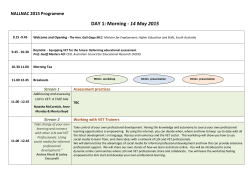
Research into Practice WHAT WORKS? December 2010
The Literacy and Numeracy Secretariat December 2010 WHAT WORKS? Research into Practice A research-into-practice series produced by a partnership between the Literacy and Numeracy Secretariat and the Ontario Association of Deans of Education Research Monograph # 31 Can video games be used for learning in the classroom? Video Games in the Classroom Building Skills in Literacy and Numeracy Research Tells Us ● ● ● The widely held view that gaming is addictive and leads to violence is not substantiated by research. Players spend just as much time reading, doing homework and playing sports as non-players. Benefits of gaming derive from opportunities for pleasure, interactivity, problem solving and creativity, leading to increased engagement in learning. Additional benefits accrue from online gaming in terms of peer-to-peer learning. By Drs. Emmanuel Duplàa and Shervin Shirmohammadi University of Ottawa As a society, we are seeing rapid and significant developments in video gaming, a field that is on its way to outdistancing the film and television industry. We are also witnessing the development and marketing of multiplayer online gaming. Yet much like the telephone at the turn of the century or television 50 years ago, video games are linked to controversy. Many people believe that gaming is addictive and leads to violence, a belief not borne out by evidence. Some researchers have shown, for example, that the behavioral problems of young people who play video games have their source elsewhere; they suggest that being drawn into violent games is the expression of a malaise that has other causes.1 One wide-scale study found that players spend just as much time as non-players reading, doing homework and playing sports and that they have normal social relationships with their friends and parents. In and of themselves, games do not seem to present a problem for young people.2 So, our question is, Can video games be used for learning in the classroom, particularly in the area of literacy and numeracy? EMMANUEL DUPLÀA is a professor in the Faculty of Education at the University of Ottawa and an expert in the field of education, educational psychology and technology. He is especially interested in the integration of IT into educational institutions. SHERVIN SHIRMOHAMMADI is a professor in the School of Information Technology and Engineering at the University of Ottawa and a licensed professional engineer. He is an expert in the field of massively multiplayer online gaming. Overview of Gaming Today It is appropriate to include a few definitions here because the field of video games is so vast. First, we must make the distinction between serious games, simulations and online games. The concept of serious games, proposed in 1970, has recently been redefined as an intellectual competition against a computer that follows well-defined rules, has an educational purpose and can also be entertaining.3 Simulation is different; there is not necessarily a winner or a loser The Literacy and Numeracy Secretariat is committed to providing teachers with current research on instruction and learning. The opinions and conclusions contained in these monographs are, however, those of the authors and do not necessarily reflect the policies, views, or directions of the Ontario Ministry of Education or the Literacy and Numeracy Secretariat. Aspects of gaming that reinforce motivation ... In serious games and simulations: ● Students are active -- they manipulate objects and variables. ● Students have control over their actions (and are further engaged when each action creates a reaction). ● Students engage in inductive, experiential learning. In online games (MMOGs): ● Students enjoy personalized paths or itineraries -- they adapt their learning as they go. ● Students learn from peers -- they communicate with others as an integral part of the game. and simulation attempts to reproduce reality. Serious games are situated at the boundary between games and simulation, because of their connection to reality.4 Today, we are witnessing major developments in massively multiplayer online games (MMOGs): players meet in a virtual online world in order to carry out missions, quests and so on. The best known examples are “Second Life” and “World of Warcraft.” Advances in technology are enabling younger and younger gamers to participate,4 a trend that is driving the development of video games today. Educational Principles at Play Serious video games and computer simulations offer an interesting context for learning because they reinforce student motivation. This has been demonstrated by several researchers who have explored the educational principles at play in video games. The first principle is that students are active, not passive, as they manipulate objects and variables.5 Correspondingly, they are more engaged in their learning. The second principle is that students have control over their actions. As they observe that each action creates a reaction, they become increasingly motivated.6 Third, animation increases motivation: students are more likely to return to activities that include animated graphics.7 Lastly, serious games support inductive, experiential learning, with a genuine constructivism approach.4 While MMOGs are not educational video games as such, they can provide a context for adaptive learning, because they allow for multiple personalized paths or itineraries.8 In addition to offering the flexibility of paths, they have all of the advantages of serious games in terms of motivation. Communication among players during play also introduces a social aspect that opens the door to knowledge acquisition with peers. This moves the game beyond a constructivism approach to a socio-constructivism approach. This approach has ramifications that can transform the social identity and collegiality of the players.9 It also has features that support learning: pleasure, interactivity, problem solving and creativity.10 These types of games appeal to students by providing new opportunities for learning, which should increase achievement in the classroom. A study on the informal learning that occurs with these games shows that there are two levels of learning with an MMOG; first, there is the game itself, and second, there is the discussion about the game that serves to complete the learning.11 On the basis of this inductive model, we are proposing two activities that will motivate students through the use of serious games and online games. Some Skill-Building Games To get started in using video in the classroom, we suggest two serious games (Les exercises interactifs du CCDMDa and Les Toké’sb) and two activities with MMOGs (Antarctikc and RuneScape).d For learning French grammar – Les exercises interactifs du CCDMD provides several games for learning French grammar. Depending on the topic the teacher wants to address (for example, punctuation or pronouns), the site offers several interactive games that are played individually. Each exercise includes a solution. In this way, the student can solve each problem through trial and error and learn the grammatical rule. For learning basic math and language skills – Les Toké’s offers several math and language games that involve addition, times tables, using a keyboard, changing simple sentences into compound sentences and so on. Activities are timed and the student can focus on achieving a score. The highest scores are posted, and this motivates the students. These games give teachers the option of printing the students’ screens, but the students mark themselves using the game’s answer key. 2 What Works? Research into Practice For practising multiplication and percentages – Antarctike is a game in which children pretend to be penguins exploring a new world and finding ways to ensure their survival. Students perform a number of tasks that draw on their mathematics skills. This game can be used to teach basic mathematical operations (multiplication, addition, subtraction, division) involving whole numbers and more complex concepts such as integers and percentages. • Students register on the site (5 minutes) and then explore their character’s environment (10 minutes). • The teacher suggests an activity (15 minutes) in which the students make purchases with start-up capital (Figure 1a) or answer a survey (Figure 1b). In the first case, students use multiplication or subtraction to purchase supplies while working within a budget. In the second case, a survey provides a real, interactive example of percentages. • The teacher formalizes the concepts of operations involving whole numbers, or percentages, based on the example in the game (15 minutes). Because the game affords students practical experience in working through the example, learning is inductive. The game also offers many management activities that can be used to create other learning activities. Figure 1: Antarctik. 1a. Purchasing supplies. 1b. Online survey For language practice – RuneScape provides many possibilities for creating educational activities, primarily through quests that the students can go on, either alone or in teams of two. • Students register on the site (5 minutes) and then explore their character’s environment (5 minutes). • Students follow the introductory tutorial individually (40 minutes), reading the instructions for different characters who perform various actions in the game, for example, protecting the bag from Figure 2: RuneScape. Tutorial a goblin attack (see Figure 2). Student comprehension is validated as their character progresses through the game. The teacher can define new vocabulary as needed or, together, the students can create a word bank • Then, after the game, students can write a composition that uses the vocabulary from the word bank as a way of checking what they have learned. December 2010 3 Tips for Practice Learn more about LNS resources ... http://www.edu.gov.on.ca/eng/ literacynumeracy/publications.html Call: 416-325-2929 1-800-387-5514 Email: LNS@ontario.ca Many free, high-quality games are available on the Internet that can be used inside or outside of the classroom. When selecting a serious game, first ensure that it is sufficiently interactive. A simple video presentation does not provide genuine instruction. Next, ensure that the game is user-friendly and useable.12 Instructions, workload and consistency of a game’s functions can disrupt progress if the game’s ergonomics are poorly designed. Finally, interactivity must be in line with the learning process: each click of the mouse must have meaning. Using video games sucessfully in the classroom requires both preparation and ongoing teacher involvement. First, teachers need to ensure that the security features of the school’s network allow access to the game. One computer with an Internet connection per student, or for every two students, is ideal. If there isn’t one computer for each student, the teacher can lead the game as a group activity using a projector or an interactive whiteboard. The teacher also plays a central role in the learning activities that the games create. Some serious games on the Internet provide simple instructions, for example, questionnaires with integrated guides and answers. Others do not provide instruction per se, but they do make it possible for the teacher to review concepts and act on content in advance of playing. The same is true for MMOGs that are available for free on the Internet. These games offer tutorials that students can access to validate their understanding of the instructions by means of on-screen action (declarative, procedural link). The teacher can then suggest a writing activity in order to introduce the vocabulary that the students will need to acquire during the game. The most important thing is to choose a game that will ignite students’ imagination. In Summary Activities involving video games will increase student motivation and help them develop their literacy and numeracy skills in imaginary interactive contexts that are more appealing than a book for many students. Educational video games offer great potential as they continue to evolve. They are a part of a great tradition: learning while having fun. REFERENCES Acknowledgement What Works?: Research into Practice thanks Runescape and Antarctick for permission to include game screenshots in this monograph. 1. Nachez, M., & Schmoll, P. (2003). Violence et sociabilité dans les jeux vidéo en ligne. Sociétés, 82(4), 5–17. 2. Cumming, H. M., & Vendewater, A. (2007). Relation of adolescent video game play to time spent in other activities. Archives of Pediatrics and Adolescent Medicine, 161(7), 684–689. 3. Zyda, M., Mayberry, A., McCree, J., & Davis, M. (2005). From Viz-Sim to VR to games: How we built a hit game-based simulation. In W. B. Rouse & K.R. Boff (Eds.), Organizational simulation. New York: Wiley. 4. Sauvé, L. (2008). Concevoir des jeux éducatifs en ligne : un atout pédagogique pour les enseignants. Paper delivered during the Colloque Scientifique Ludovia August 27, Aix les Thermes, France. 5. Garris, R., Ahlers, R., & Driskell, J. E. (2002). Games, motivation, and learning: A research and practice model. Simulation and Gaming, 33(4),441–467. 6. Squire, K. (2003). Video games in education. International Journal of Intelligent Simulations and Gaming, 2(1), 49–62. 7. Rieber, L.P. (1991). Animation, incidental learning, and continuing motivation. Journal of Educational Psychology, 83(3),318–328. 8. Burgos, D., Moreno-Ger, P., Sierra, J. L., Fernández-Manjón, B., Specht, M., & Koper, R. (2008). Building adaptive game-based learning resources: The integration of IMS learning design and <e-Adventure>. Simulation and Gaming, 39(3), 414–431. 9. Georges, F. (2008). Les composantes de l’identité dans le web 2.0, une étude sémiotique et statistique. INRS, 6-7, Québec. 10. Van Eck, R. (2007). Building artificially intelligent learning games. In D. Gibson, C. Aldrich, & M. Prensky (Eds.), Games and simulations in online learning: Research and development frameworks. Hershey, PA: Information Science Publishing. 11. Berry, V. (2007). Les Guildes de joueurs dans l’univers de Dark Age of Camelot: apprentissages et transmissions de savoirs dans un monde virtuel. Les jeux du formel et de l’informel,160, 75–86. Electronic edition. 12. Bastien, J.M.C. & Scapin, D.L. (1993). Ergonomic Criteria for the Evaluation of Human-Computer Interfaces (version 2.1). Technical report Ndged.156, May 1993. INRIA Artificial Intelligence, cognitive systems, and man-machine interaction. Abstract consulted on Ergolab, Part 1 and 2, http://ergolab.net/ articles/criteres-ergonomiques-1.php (consulted in August 2009). 13. Bergeron, G. (2007). La richesse pédagogique de l’interactivité. Correspondance,(13)2. 14. Leu, D. J., Kimzer, C. K., Coiro, J. L., & Cammack, D. C. (2004). Toward a theory of new literacies emerging from the Internet and other information and communication technologies. In Ruddell, R.B. et Unrau, N.J. (Eds.) Theoretical models and processes of reading (5th ed.). Video games The free high-quality games referred to in this article are listed below. Consulted in August 2009. a) http://www.ccdmd.qc.ca/fr/exercises_interactifs/ b) http://www.tokemaths.com c) http://www.antarctik.fr d) http://www.runescape.com/ e) http://theleme-lejeu.com/ (Beta version) What Works? is updated monthly and posted at: www.edu.gov.on.ca/eng/literacynumeracy/inspire/research/whatWorks.html ISSN 1913-1097 What Works? Research Into Practice (Print) ISSN 1913-1100 What Works? Research Into Practice (Online)
© Copyright 2025





















